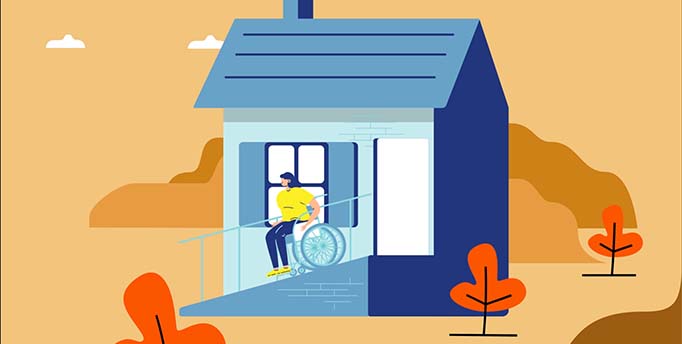Maintaining mobility is critical in making sure that seniors and people with disabilities have a successful, independent life at home. In 2020, 40 percent of Americans age 65 years and older and 13.7 percent of disabled Americans reported trouble with mobility, particularly walking and climbing stairs. Deciding which modifications will create a functional and safe home and how to fund these improvements can be daunting. To help, we’ve compiled some things to consider.
Evaluation
Before making any changes to the home, it’s best to evaluate the need for improvements room by room. Professional assistance is available at no cost through Eldercare Locator, a public service of the U.S. Administration of Community Living. If you prefer to handle the task on your own, or with the help of a family member or friend, you may find it beneficial to utilize the Centers for Disease Control and Prevention’s Check For Safety guide to understand some common hazards.
Common Modifications & Average Costs
Home modifications can be as simple as updating lighting and adding grab bars or more complex construction, like adding a stair lift and wheelchair ramp, or fully remodeling existing structures. There’s no one-size-fits-all approach to making a home safe for you or your loved ones, but there are some common areas you may want to pay particular attention to:
- Stairs. Walking up and down stairs is a high-risk activity for seniors and disabled persons. Ideal options that reduce the risk of injury are elevators, stair lifts, wheelchair lifts and ramps. Other options include improved lighting, adding non-slip strips and additional railings.
- Doorways. Ideally, doorways should be at least 32 inches wide and doors should open to 90 degrees.
- Bathrooms. Wet and slippery surfaces make bathrooms a high-risk area for seniors and disabled persons. The need to bend, reach, lift and switch from sitting to standing positions can also exacerbate mobility concerns. Adding grab bars and rails to bathroom walls is a simple and easy way to improve accessibility. For individuals with severe mobility constraints, a curbless shower or walk-in bathtub may need to be installed.
- Kitchen. Accessibility modifications that improve the ability to reach counters, sinks, cabinets and appliances may need to be implemented, especially for those who use wheelchairs or other mobility aids.
According to research conducted by HomeAdvisor.com, home modifications can range anywhere from $100 to $19,000 or more. Price ranges for some of the more common modifications are:
- Wheelchair ramp: $1,000 – $4,000
- Chairlift: $1,500 – $5,000
- Grab bars: $100 – $500 each
- Widened doorways: $700 – $2,500 per doorway
- Bathroom remodel: $3,000 – $15,000
- Kitchen remodel: $9,000 – $40,000
Financial Assistance & Other Resources
Home modifications can be costly, but there are several federal and non-profit financial assistance programs and resources available for qualified individuals. The same is true for multifamily investors or developers looking to make their properties more accessible. Here are some programs you may find worth exploring:
- The Rural Housing Repair Loans and Grants program is funded by the United States Department of Agriculture (USDA). It provides loans up to $70,000 and grants up to $7,500 to low-income homeowners aged 65 years and older.
- The Older Adult Home Modification Program, established by the U.S. Department of Housing and Urban Development (HUD)’s Office of Healthy Homes and Lead Hazard Control, provides funding to low-income elderly persons for home modifications that reduce risks of falling, and improve safety, accessibility and overall functionality.
- The Assisted Living Conversion Program (ALCP) is a HUD-funded program that helps subsidize the cost of converting some or all of the units of eligible multifamily developments.
- The Certified Aging-in-Place Specialists (CAPS) Program was created when the National Association of Home Builders teamed up with its subsidiary, Home Innovation Research Labs™, to provide a program that gives builders and remodelers special training in meeting the needs of seniors who require home modifications.
There are also state financial assistance programs available to assist with making homes more accessible so seniors and disabled persons can avoid unnecessarily being placed in long-term care facilities. To find the financial resources available in your state, visit the University of Southern California Leonard Davis School of Gerontology’s Home Modification Network.
Deciding which home modifications are right for your needs and exploring financial options can be time-consuming, but it’s time worth spending. The comfort, independence and peace of mind that seniors and disabled persons enjoy by staying in their own homes can be priceless. For more homeowner resources, visit Old Republic Title’s Homeowner Resources page.




